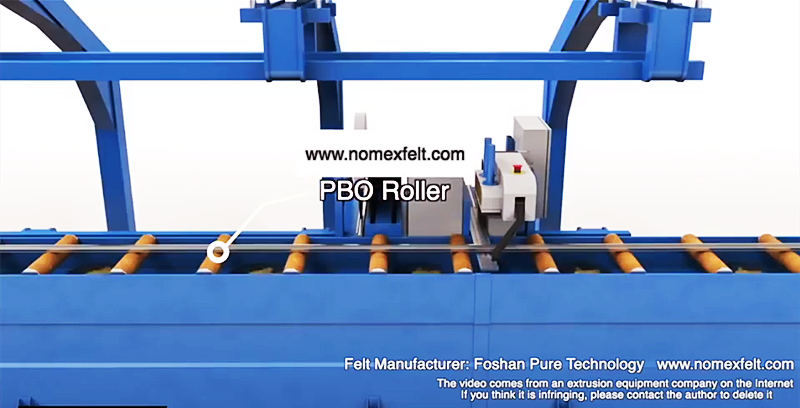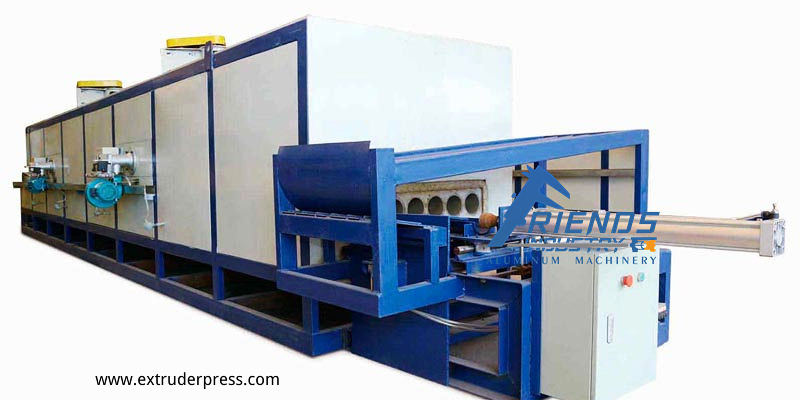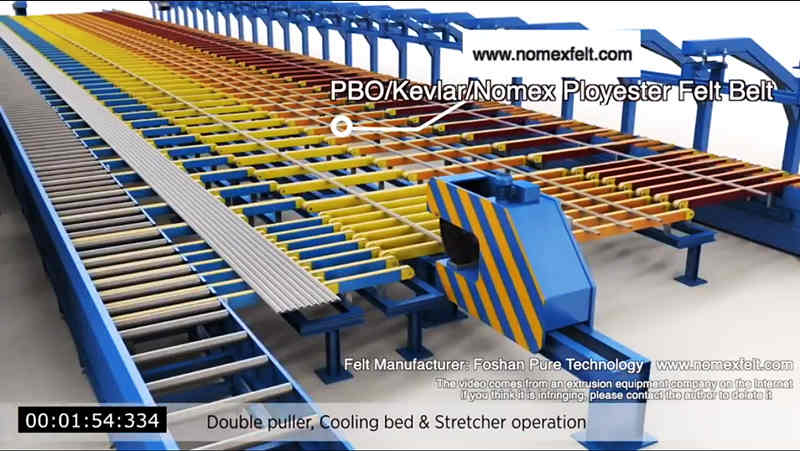Aluminum extrusion line – The Aluminum Extrusion Process in 10 Steps.
Follow us to learn more about the latest news on aluminum extruded cooling systems in the Alu industry.
We produce PBO/Kevlar/Nomex/Polyester Roller/endless belt/pad/spacer bar cover.
We’ve divided the extrusion process into ten steps. Let’s take a look at what they are.
The Aluminum Extrusion Process in 10 Steps:
The Extrusion Die is Prepared and Moved to the Extrusion Press
First, a round-shaped die is machined from H13 steel. Or, if one is already available, it is pulled from a warehouse like the one you see here.
The die must be preheated to between 450-500 degrees Celsius prior to extrusion to help maximize its life and ensure uniform metal flow.
Once the die has been preheated, it can be loaded into the extrusion press.

An Aluminium Billet is Preheated Before Extrusion
Next, a solid, cylindrical block of aluminum alloy, called a billet, is cut from a long log of alloy material.
It is preheated in an oven, like this one, to between 400-500 degrees Celsius.
This makes it malleable enough for the extrusion process but not molten.
The Billet is Transferred to the Extrusion Press
Once the billet has been preheated, it is transferred mechanically to the extrusion press.
Before it is loaded onto the press, a lubricant (or release agent) is applied to it.
The release agent is also applied to the extrusion ram, to prevent the billet and ram from sticking together.
The Ram Pushes the Billet Material into the Container
Now, the malleable billets are loaded into the extruder, and hydraulic cylinders apply up to 15,000 tons of pressure to it.
When pressure is applied by the plunger, the billet material is pushed into the container of the extruder press.
The material expands to fill the walls of the container.
The Extruded Material Emerges Through the Die
As the alloy material fills the container, it is now pressed against the extrusion die.
With continual pressure being applied to it, the aluminum material has nowhere to go except out through the opening(s) in the die.
It emerges from the die’s opening in the shape of a fully-formed profile.

Extrusions are Guided Along the Runout Table and Quenched
After emerging, the extrusion is gripped by a puller, like the one you see here, which guides it along the runout table at a speed that matches its exit from the press.
As it moves along the runout table, the profile is “quenched,” or uniformly cooled by a water bath or by fans above the table.
Extrusions are Sheared to Table Length
Once an extrusion reaches its full table length, it is sheared by a hot saw to separate it from the extrusion process.
At every step of the process, temperature plays an important role.
Although the extrusion was quenched after exiting the press, it has not yet fully cooled.

aluminum extrusion cooling table, cooling system, handling table, handling system. convey belt for handling table system.
The extrudate was cooled to room temperature
After shearing, the table-length extrusion is mechanically transferred from the beater table to the cooling table, as you can see here.
High-quality felt belts and high temp roller sleeves of pure technology co. ltd is used in the cooling system. Make sure that the process runs smoothly.
The profiles will remain there until they reach room temperature.
Once they do, they will need to be stretched.
Stretch is moved to a stretcher and stretched to alignment
There are some natural distortions in the silhouette which need to be corrected.
To rectify this, they were transferred to a stretcher.
Each profile is mechanically gripped on both ends and pulled until it is straight and brought into specification.
Extrusions are Moved to the Finish Saw and Cut to Length
With the table-length extrusions now straight and fully work-hardened, they are transferred to the saw table.
Here, they are sawed to pre-specified lengths, generally between 8 and 21 feet long. At this point, the properties of the extrusions match the T4 temper.
After sawing, they can be moved to an aging oven to be aged to the T5 or T6 temperature.
Related Products:
30% PBO 70% Kevlar felt belt for the aluminum industry
100% Kevlar belt for the aluminum industry.
100% Nomex endless belt for the aluminum industry.
100% Polyester felt belt for the aluminum industry.
30% PBO 70% Kevlar felt roller for the aluminum industry.
100% Kevlar aluminum roller covers.
100% Nomex felt roller covers for the aluminum industry.
100% Polyester felt roller tube for the aluminum industry.
Please contact us for product prices, catalogs, and quotations:
Web: www.nomexfelt.com
Mail: [email protected]
As we know, Heat Transfer Printing Felt is suitable for fabrics, decorative fabrics, curtains, le...
Read Safety Rules for Laundry Management to be a qualified manager. PARTⅠ Laundry room Safety Gen...
The aluminum extrusion machine is the leading equipment for the production of aluminum profiles. ...
Heat transfer printing is a contemporary printing process in the clothing market. It prints the p...
In the textile industry, felt is only a small part but important. About how to choose felt that i...
Foshan Pure Technology Company., Ltd. helps conveyor belt manufacturers source equipment to metal...
What is Nomex? Meta-amide, or meta-phenylene isophthalamide, is made from meta-phenylenediamine a...
Kevlar fiber Introduction In the development of materials science, Kevlar fiber has particularly ...